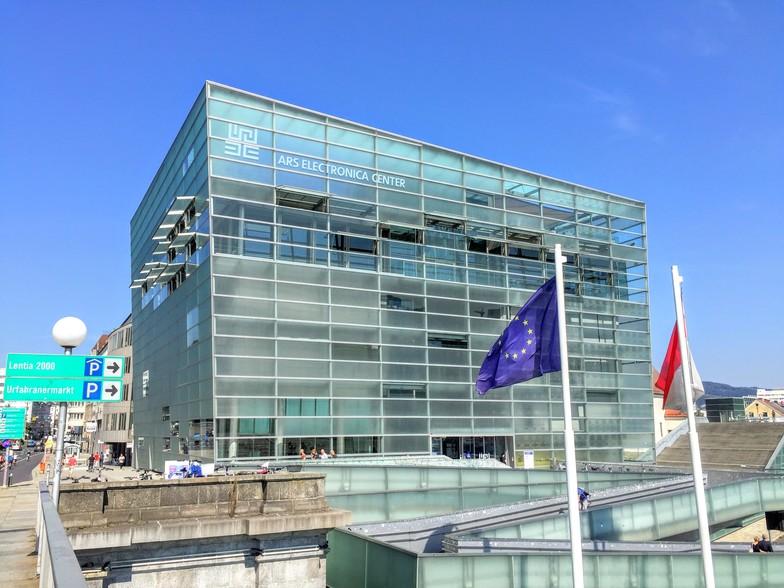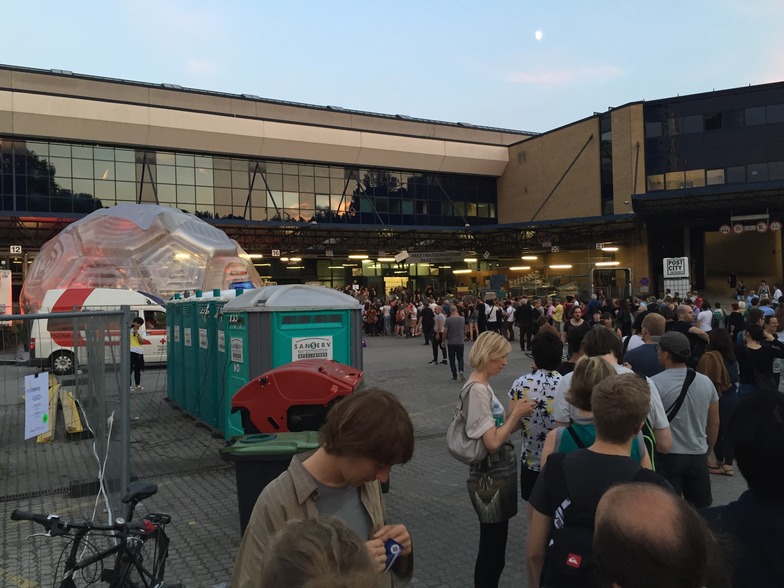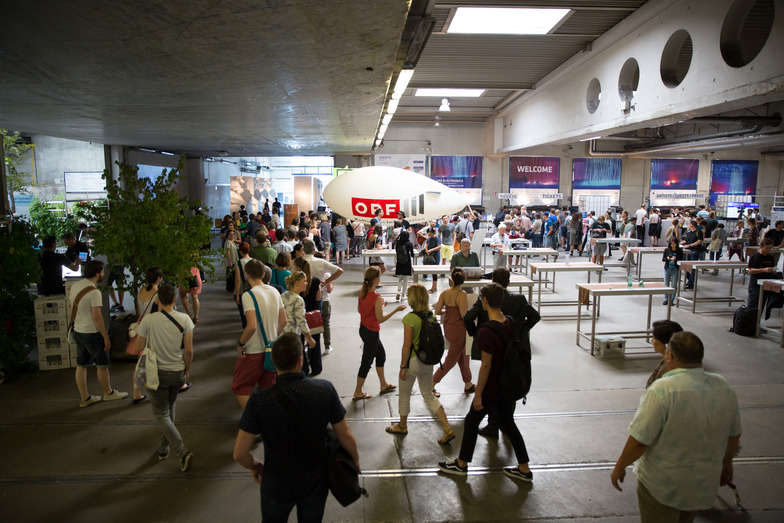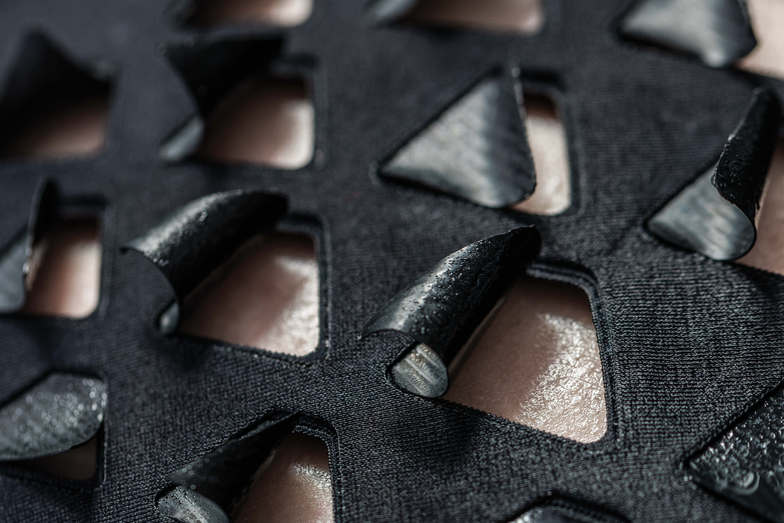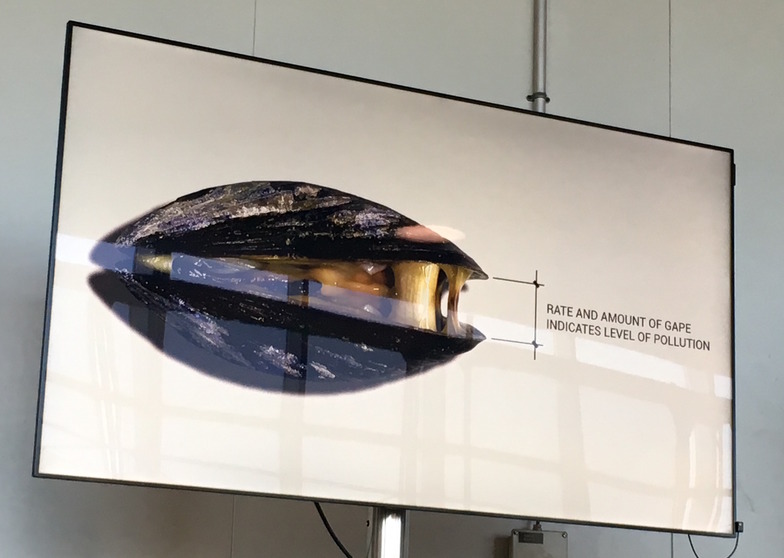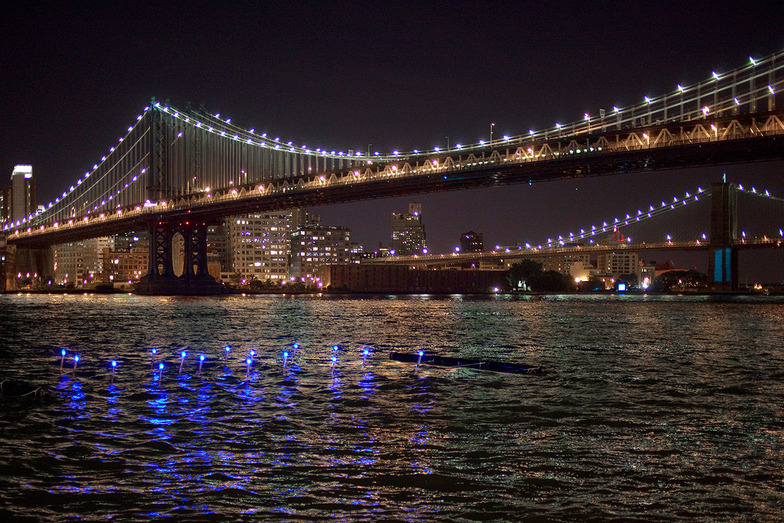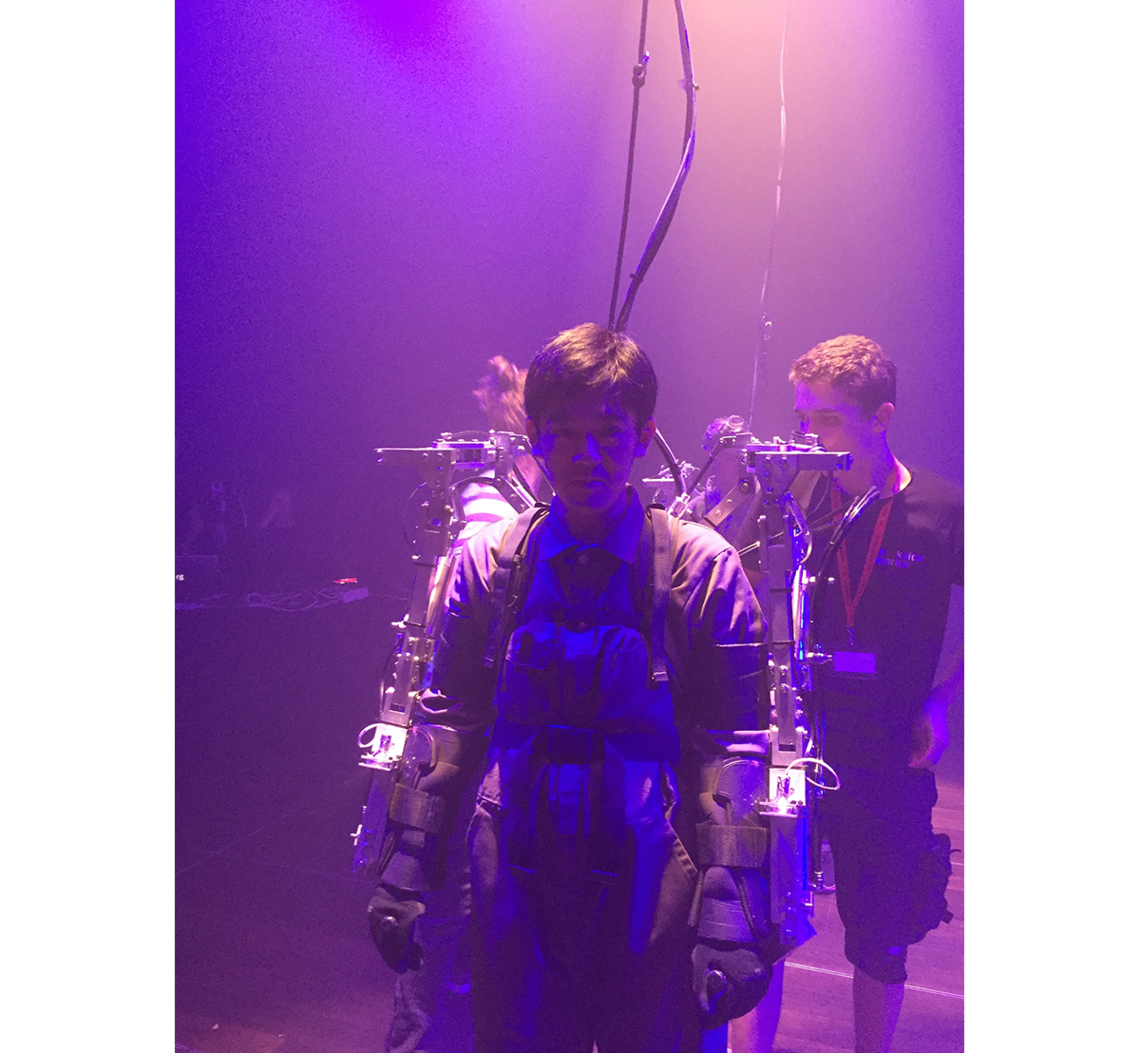
The author in cyborg-like attire
What is Ars Electronica?
Nice to meet you. I'm Yukio Hashiguchi, a copywriter. I'm dressed like some kind of cyborg here, but this is a scene from Ars Electronica, the world-renowned media art event held annually in Linz, Austria. It's a historic festival that began in 1979. During its five-day run, it reportedly draws 35,000 visitors to Linz, a city with a population of around 190,000. It truly is a festival that mobilizes the full resources of the city of Linz.
In this report, I'll introduce Ars Electronica over four installments.
By now, many of you might be wondering: Why is a copywriter reporting on a media art festival? The scope of advertising work is constantly expanding (remember, the word "advertising" was dropped from the Cannes Lions Festival name back in 2011). Personally, while continuing to write copy for commercials and print ads as a copywriter, I've also started handling product and service development projects. Looking at global examples, we're seeing more and more projects that are difficult to conceptualize and execute using traditional methodologies.
Amidst this trend, understanding creativity beyond advertising has become an essential skill for creators. It's vital both for proposing solutions to clients and for expanding the possibilities of our business. In this report, I aim to deliver not just exhibition introductions, but content that can serve as inspiration for your daily planning and ideation.
Now, while we've referred to it as a festival thus far, to be precise, the name Ars Electronica is the collective term for the four divisions below.
"Ars Electronica Center"
Established in 1996, this is the heart of Ars Electronica's activities: "The Museum of the Future." It explores, through exhibitions, how humans will interact with their surroundings and with each other in the future, transcending the boundaries of art, science, and technology. The current building was newly constructed in 2009.
"Future Lab"
This lab operates based at the above center. It's a gathering of people with diverse expertise—artists, architects, designers, VR and CG creators—researching ideas that will impact the future. They actively collaborate with universities and research institutes worldwide.
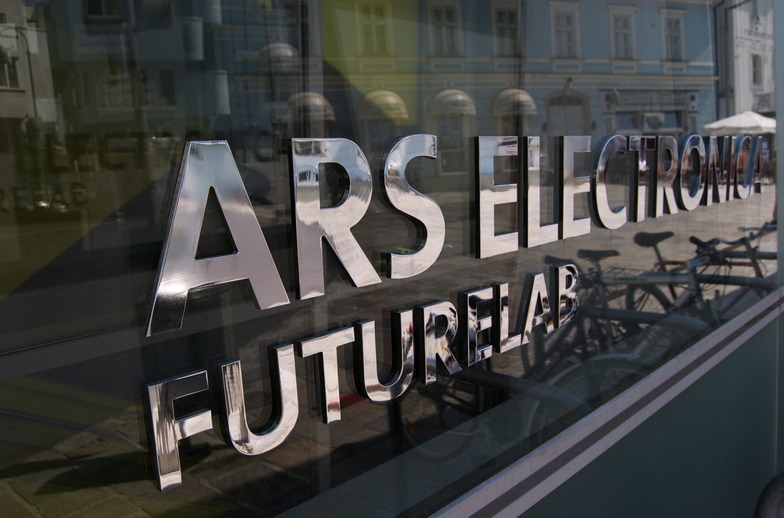
(credit: Tim Clark)
"Prix Ars Electronica"
This award recognizes works across a wide range of genres, with a focus on media art. Past winners include an impressive lineup such as Pixar in 1987, Wikipedia in 2004, and WikiLeaks in 2009. In 2016, there were 3,159 entries from 84 countries worldwide.
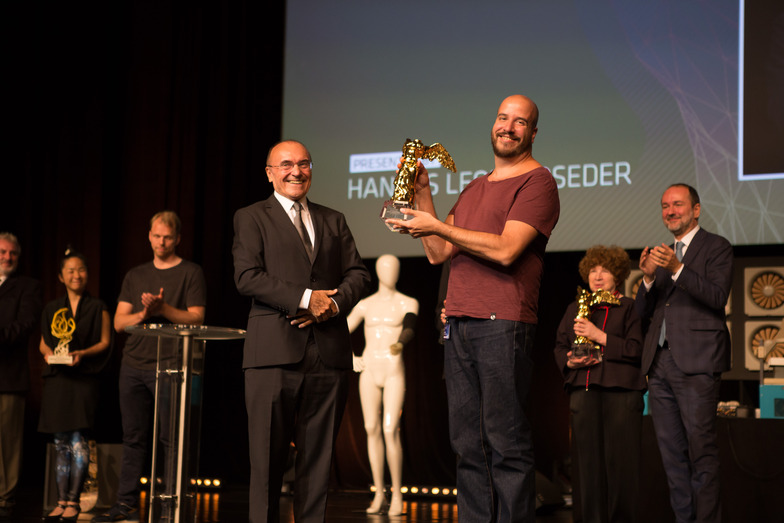
Award ceremony scene (credit: Florian Voggeneder)
And the fourth is the Ars Electronica Festival, which we will cover in detail this time.
The venues are spread across several locations in Linz city, with exhibitions, symposiums, performances, and more taking place at each one. The main venue is POST CITY, located near Linz Central Station. It utilizes the original post office building as-is. Inside, it's vast and open, with spiral chutes—once used for sorting mail—found everywhere.
As its mysterious atmosphere suggests, Ars doesn't offer that "Aha!" moment you might find at advertising festivals. Instead, it mostly leaves you wondering, "What does this mean?" I believe this isn't a place to find answers, but to deepen the questions. To view the world through a questioning lens. From there, new things are born, and the future is shaped. I sensed that very intent in the exhibited works and presentations.
Enough preamble—let me share what I saw on site. First up is this year's Ars main theme: "RADICAL ATOMS."
RADICAL ATOMS
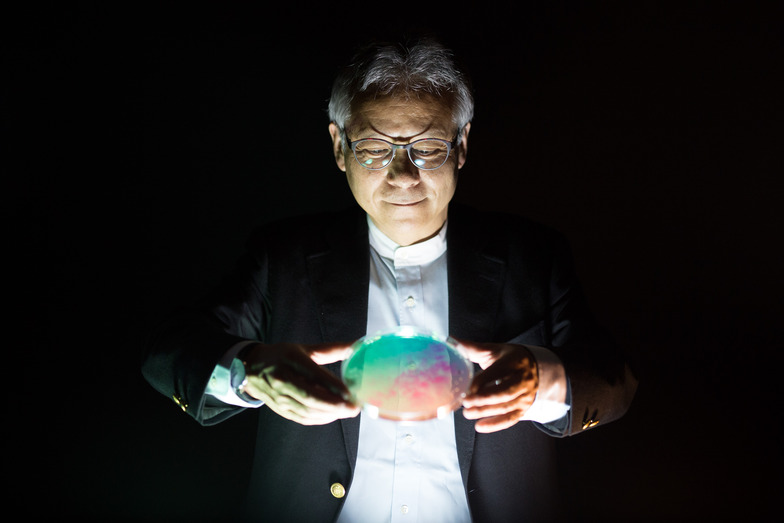
Professor Hiroshi Ishii, MIT Media Lab (credit: Florian Voggeneder)
"RADICAL ATOMS" is a concept proposed by the Tangible Media Group at the MIT Media Lab, led by Professor Hiroshi Ishii. Literally translated, it means "radical atoms." I understand it as "materials that can be freely edited and processed like digital data."
Today, we manipulate digital data on the other side of the screen using mice, keyboards, touchscreens, and similar tools. In a sense, this creates a disconnect between the world beyond the screen (bits) and our physical world (atoms). In response, the Tangible Media Group proposed the concept of "TANGIBLE BITS." This idea involves manipulating digital data using physical objects as interfaces, rather than icons or windows. RADICAL ATOMS represents a concept that goes even further beyond tangible bits.
Words alone can be a bit difficult to grasp, so let's look at the exhibition. One of the works displayed at Ars Electronica symbolizing "RADICAL ATOMS" was inFORM.
inFORM
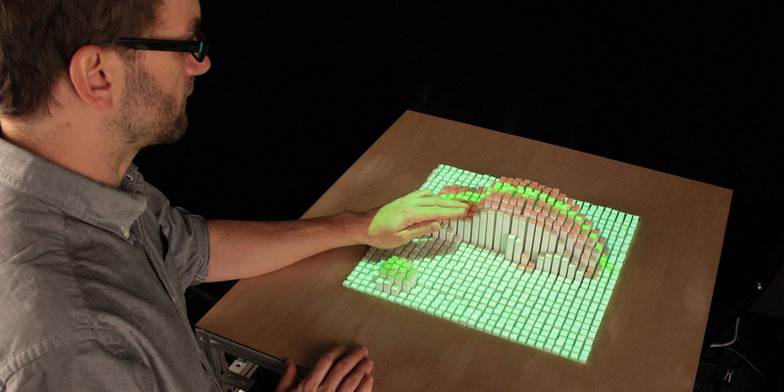
(photo
: Tangible Media Group / MIT Media Lab)
For more details, please see the video
Just like creating 3DCG on a screen, they freely manipulate objects right before their eyes. It looks like something straight out of a sci-fi movie. The Tangible Media Group calls inFORM a "dynamic shape display," contrasting it with conventional flat displays. They seem to be advancing research with applications in urban planning and architecture in mind. Indeed, if inFORM becomes practical, it could enable intuitive design and potentially transform the very nature of cities and architecture.
Next, we introduce RADICAL ATOMS' case study: "bioLogic."
bioLogic
This material reacts to the wearer's body temperature and sweat to automatically open pores, offering excellent quick-drying and cooling properties. Tangible Media Group positions it as more than just clothing—a "second skin." They envision future applications in sportswear and similar products.
This functionality is achieved by printing natto bacteria onto the fibers, which expand and contract in response to humidity. What's intriguing is viewing natto bacteria as " sensors and actuators made not in factories, but in nature." While there are precedents for integrating technology into fashion, like touchscreen-like clothing, bioLogic feels more advanced and fundamental.
MIT Media Lab founder Nicholas Negroponte famously said, "Bio is the new digital." Bio was a major trend at this year's Ars Electronica, with many exhibits beyond RADICAL ATOMS. Here's the one I found most impressive.
Pier 35 EcoPark
Pier 35 EcoPark is an example using "shellfish" as sensors. The degree to which the shells open can measure water pollution levels, reportedly more accurately and cheaply than any existing sensor. Utilizing this property, an installation where the color of light changes based on water pollution levels was implemented in New York's East River.
David Benjamin, the project's central figure, stated, "What we're doing is nothing new. It's the same as when coal miners used to take canaries into the mines."
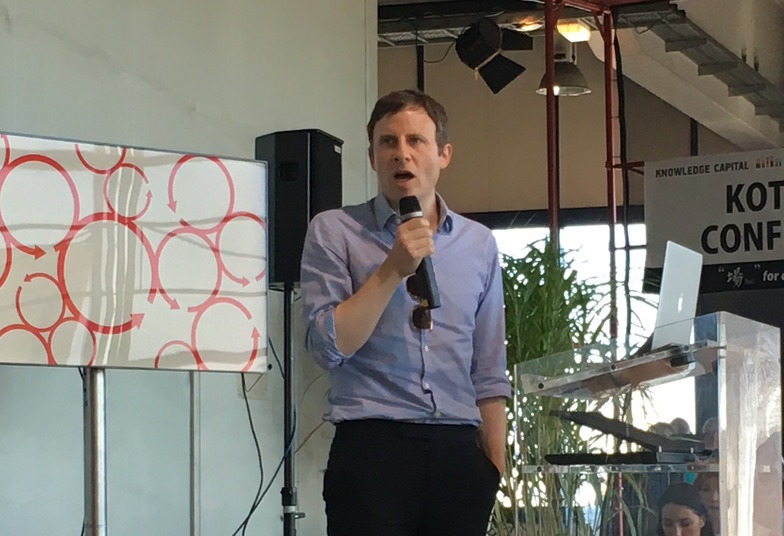
David Benjamin
From solutions to questions.
The cases introduced here are rooted in the fundamental question: "What if we could edit, manipulate, and process physical materials as easily as digital data?" What emerges from this is a future that could never be reached through the traditional process of "identifying problems and proposing solutions."
Advertising fundamentally involves proposing solutions to clients' challenges. However, when striving to achieve essential innovation as a client's partner, this approach may have limitations. I believe that, in addition to "proposing solutions," "sharing questions" will also be demanded of advertising agencies going forward.
Next time, we'll feature a report by Mr. Nagashima of CDC on the multifaceted nature of the internet as seen through Ars Electronica. Stay tuned!


